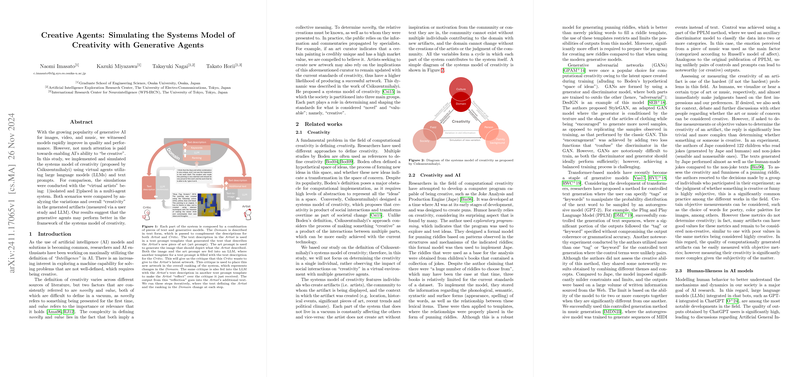The paper "Creative Agents: Simulating the Systems Model of Creativity with Generative Agents" explores the implementation of Csikszentmihalyi’s systems model of creativity using generative agents facilitated by LLMs and text prompts. This research investigates AI’s potential to embody creativity, a largely under-explored area compared to AI’s advancements in generating media such as images, videos, and music.
Core Concepts and Methodology
The paper bases its approach on Csikszentmihalyi's systems model that defines creativity as a product of interactions between three components: the individual (artist), the field (community or critics), and the domain (cultural context). In this paper, virtual agents acting as artists and critics are simulated within these contexts to assess creativity through interaction dynamics.
Simulation Design:
- Agents and Environment: Various agents, including artists and critics, were developed. These agents interact within a domain described through a textual model, which changes through iterative updates based on feedback.
- Art Generation and Evaluation: Artworks are generated using text-to-image models, and their creativity is evaluated by both the field agents (critics) and through user studies. Two scenarios are compared:
- Isolated generative agents where the artist generates art without feedback.
- Agents within a multi-agent system that receive and process critiques, iteratively updating their creative process.
- Dynamic Interaction: Feedback from the critic agents is used to update the artist agents, influencing subsequent art creation, thereby embracing a cyclic model akin to social influence in creativity.
Key Findings
- Variability and Creativity Assessment: Through iterative interactions, agents in a multi-agent system display more variability and creative adaptation over time compared to isolated agents. The artworks produced in this interactive setup were perceived as more creative by human evaluators.
- User Studies and AI Evaluation: A user paper showed that participants often viewed artworks produced by agents in a system as more creative. Additionally, creativity scores assigned by an LLM provided insights into both the potential and limitations of current AI in judging creativity.
- Challenges in Objective Creativity Evaluation: The paper acknowledges the difficulty in objectively evaluating creativity, given its inherently subjective nature. The authors used critiques from LLM evaluations and human assessments to navigate this complex landscape.
Implications and Future Work
This research highlights the potential of incorporating social dynamics into AI to enhance creative outputs. It suggests a framework where AI creativity could be further enhanced through more complex simulations of social interactions. Future work might explore deeper agent interactions and more diverse conditions to further understand AI's role in creative processes.
Moreover, the paper opens avenues for ethical discussions on AI’s ability to generate and evaluate artistic creations, suggesting a blend of computational creativity and human cultural understanding. The ultimate goal is to balance AI’s creative capabilities with ethical and intellectual property considerations in art, emphasizing AI as a supportive tool rather than a replacement for human creativity.
Overall, this paper contributes to the growing body of work on computational creativity by demonstrating how generative models can be informed and guided by structures inspired by human social contexts.
